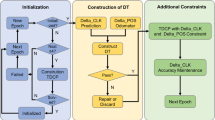Abstract
Satellite atomic clocks are the basis of GPS for the control of time and frequency of navigation signals. In the Chinese Area Positioning System (CAPS), a satellite navigation system without the satellite atomic clocks onboard is successfully developed. Thus, the method of time synchronization based on satellite atomic clocks in GPS is not suitable. Satellite virtual atomic clocks are used to implement satellite navigation. With the satellite virtual atomic clocks, the time at which the signals are transmitted from the ground can be delayed into the time that the signals are transmitted from the satellites and the pseudorange measuring can be fulfilled as in GPS. Satellite virtual atomic clocks can implement the navigation, make a pseudorange difference, remove the ephemeris error, and improve the accuracy of navigation positioning. They not only provide a navigation system without satellite clocks, but also a navigation system with pseudorange difference.
Similar content being viewed by others
References
Hegarty C, Powers E, Fonville B. Accounting for timing biase between GPS, modernized GPS, and GALILEO signals. In: 36th Annual Precise Time and Time Interval (PTTI) Meeting, December 2004, Washington, DC, USA, 307–318
Yang X H. Study on the application of time and frequency transfer with GPS common-view. Doctor Dissertation. Shaanxi: National Time Service Center, Chinese Academy of Sciences, 2003. 5–6
Ai G X, Shi H L, Wu H T, et al. The principal of the positioning system based on communication satellites. Sci China Ser G-Phys Mech Astron, 2009, 52(3): 472–488
Lu X C, Wu H T, Bian Y J, et al. Signal structure of the Chinese Area Positioning System. Sci China Ser G-Phys Mech Astron, 2009, 52(3):412–422
Wu H T, Bia Y J, Lu X C, et al. Time syncronization and carrier frequency control of CAPS navigation signals generated on the ground. Sci China Ser G-Phys Mech Astron, 2009, 52(3): 393–401
Li X H. Study and design of the satellite virtual atomic clock and the source of velocity determination in CAPS. Doctor Dissertation. Xi’an: National Time Service Center, Chinese Academy of Sciences, 2004. 23–35
Xu G C, Lu X C, Li X H. A virtual navigation system and solutions of extraterrestrial disturbances. ION GNSS 20th International Technical Meeting of the Satellite Division, 25–28, September 2007, Fort Worth, TX. 2668–2675
Skillicorn G. Local area augmentation system (LAAS) update. In: ION National Technical Meeting, January 22–24, 2003, Anaheim, CA. 37–50
Parkinson B, Spilker J J. GPS: Theory and Application. Washington D C: AIAA, 1996
Blanch J. An Ionosphere Estimation Algorithm for WAAS Based on Kriging. Portland, ION GPS, 2002. 816–823
Li Z G, Yang X H, Shi H L, et al. A new method for determination of satellite orbits by transfer. Sci China Ser G-Phys Mech Astron, 2009, 52(3): 384–392
Author information
Authors and Affiliations
Corresponding author
Additional information
Supported by the National Basic Research Program of China (Grant No. 2007CB815502) and the National High Technology Research and Development Program of China (Grant No. 2007AA12Z300)
Rights and permissions
About this article
Cite this article
Li, X., Wu, H., Bian, Y. et al. Satellite virtual atomic clock with pseudorange difference function. Sci. China Ser. G-Phys. Mech. Astron. 52, 353–359 (2009). https://doi.org/10.1007/s11433-009-0059-4
Received:
Accepted:
Published:
Issue Date:
DOI: https://doi.org/10.1007/s11433-009-0059-4




